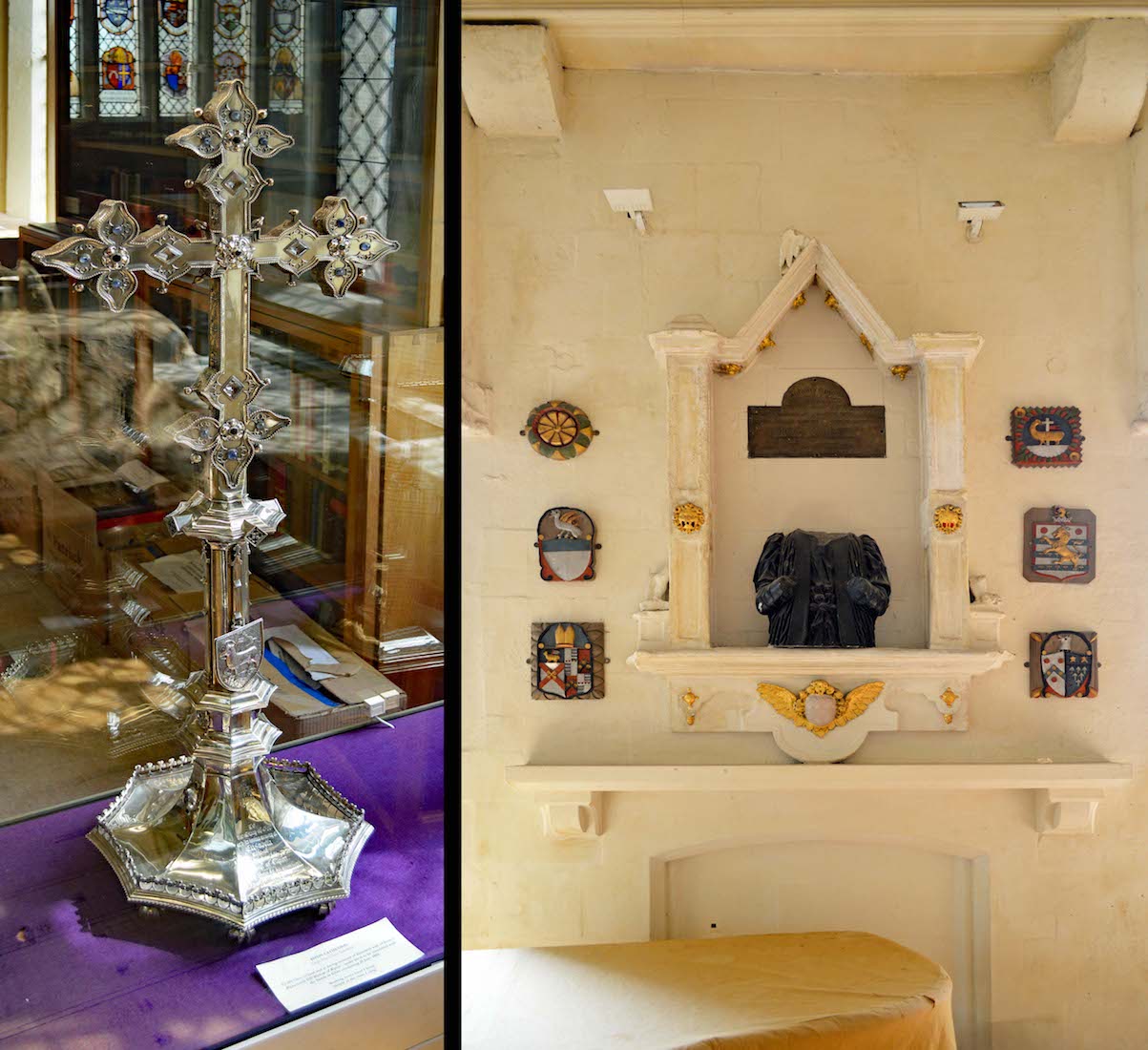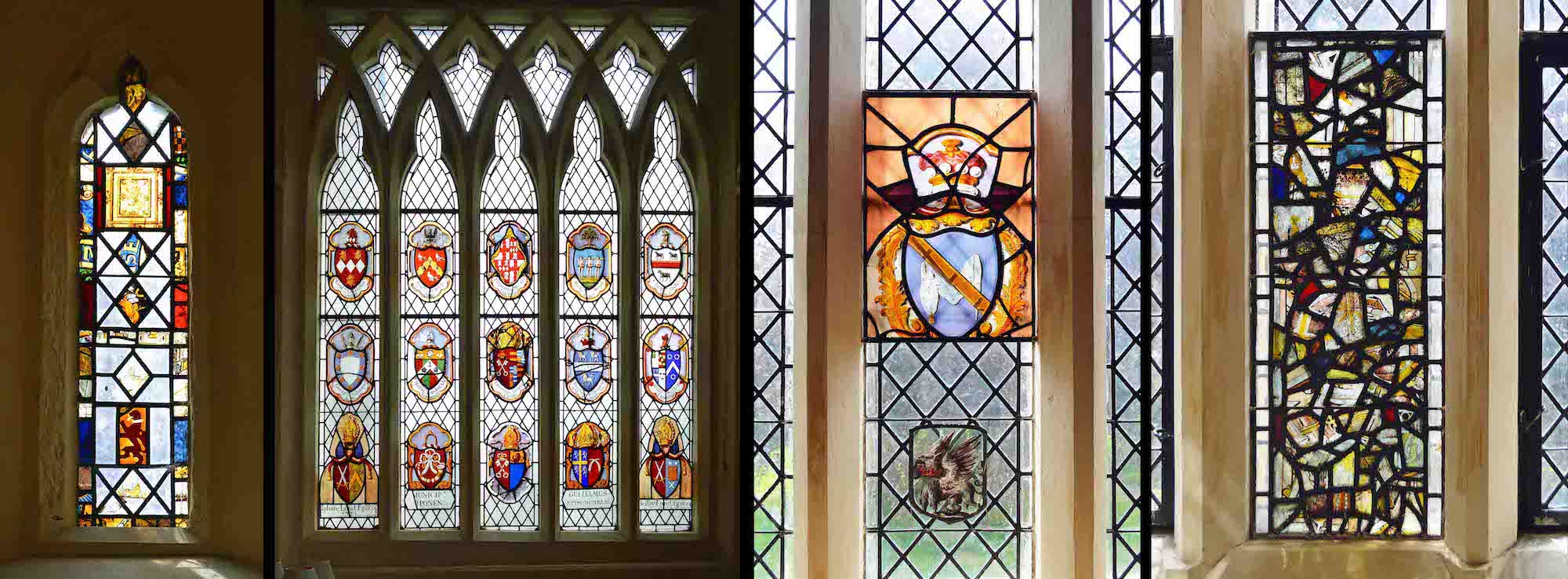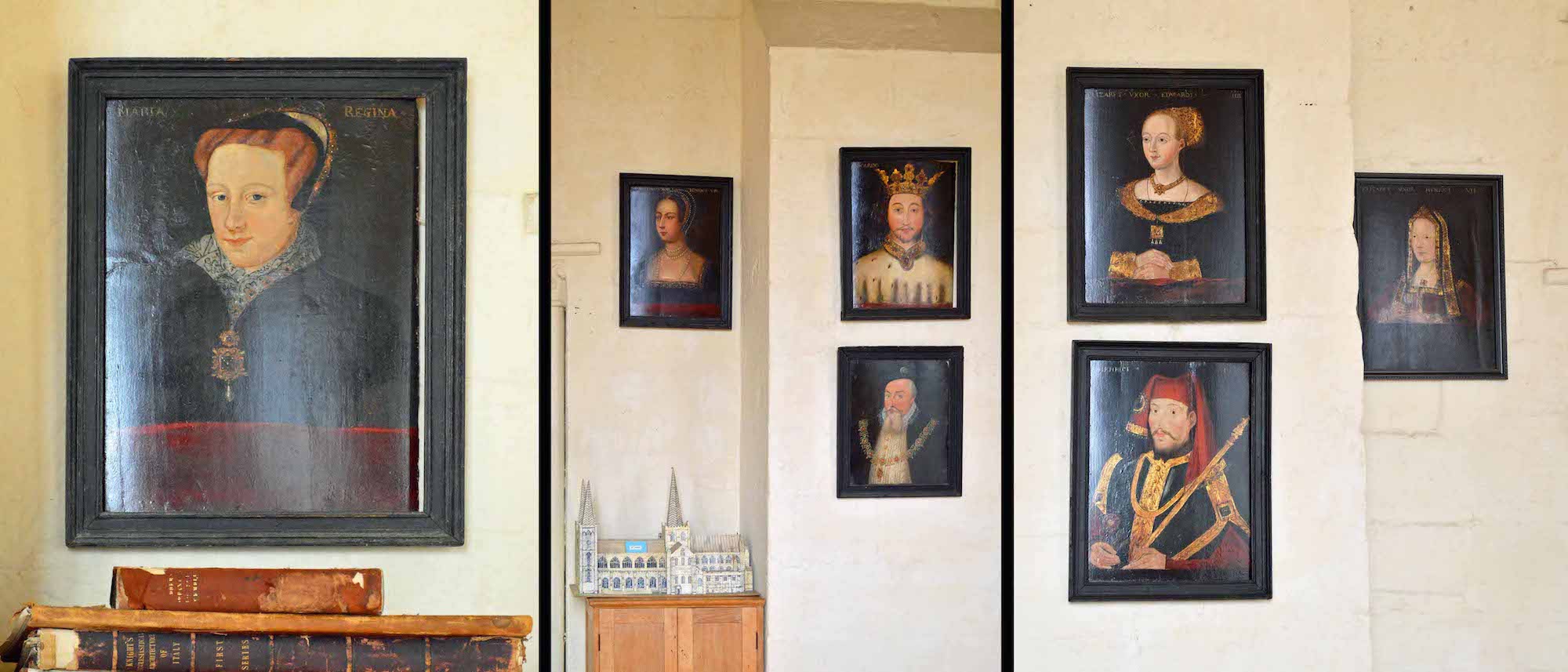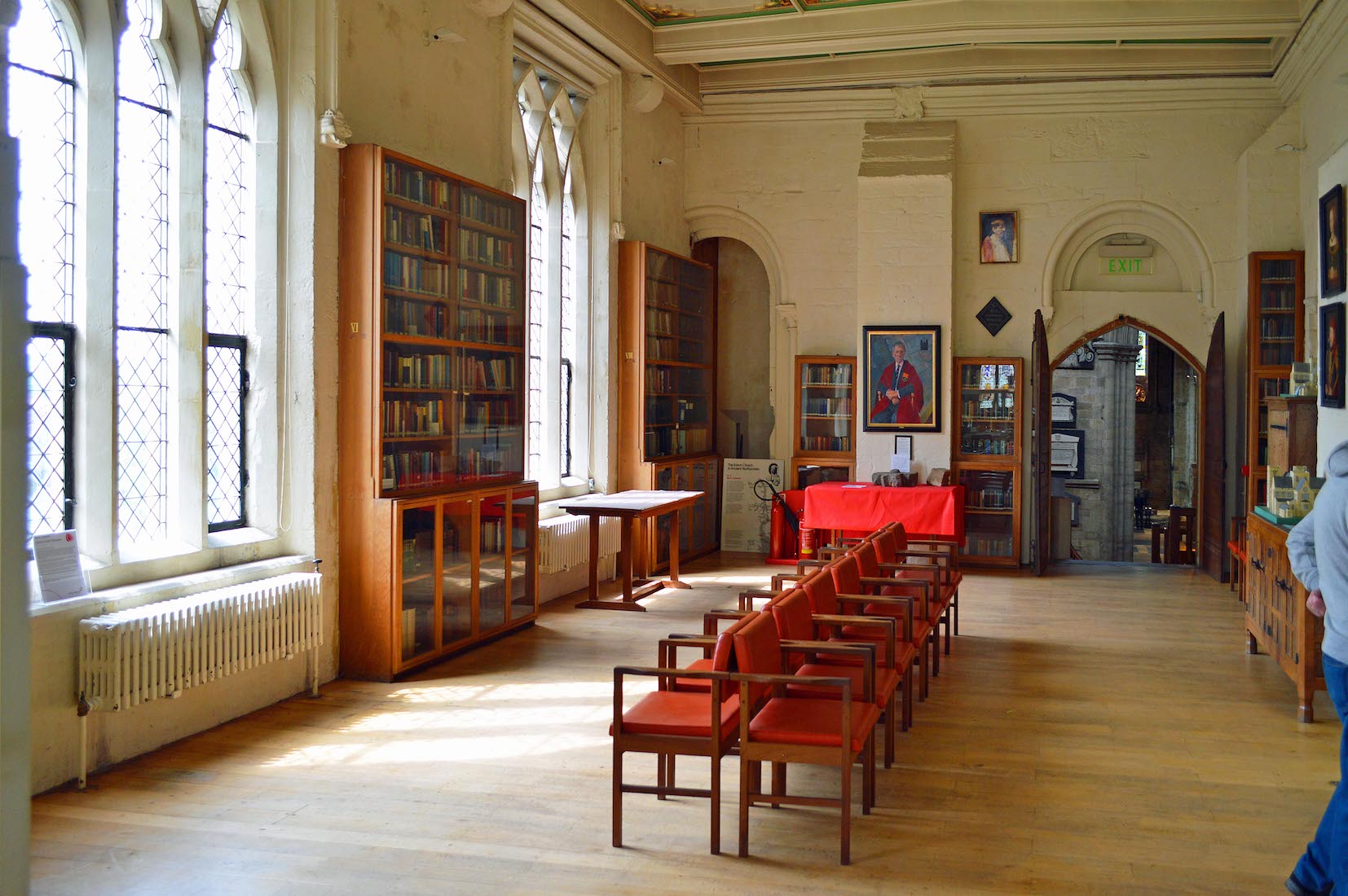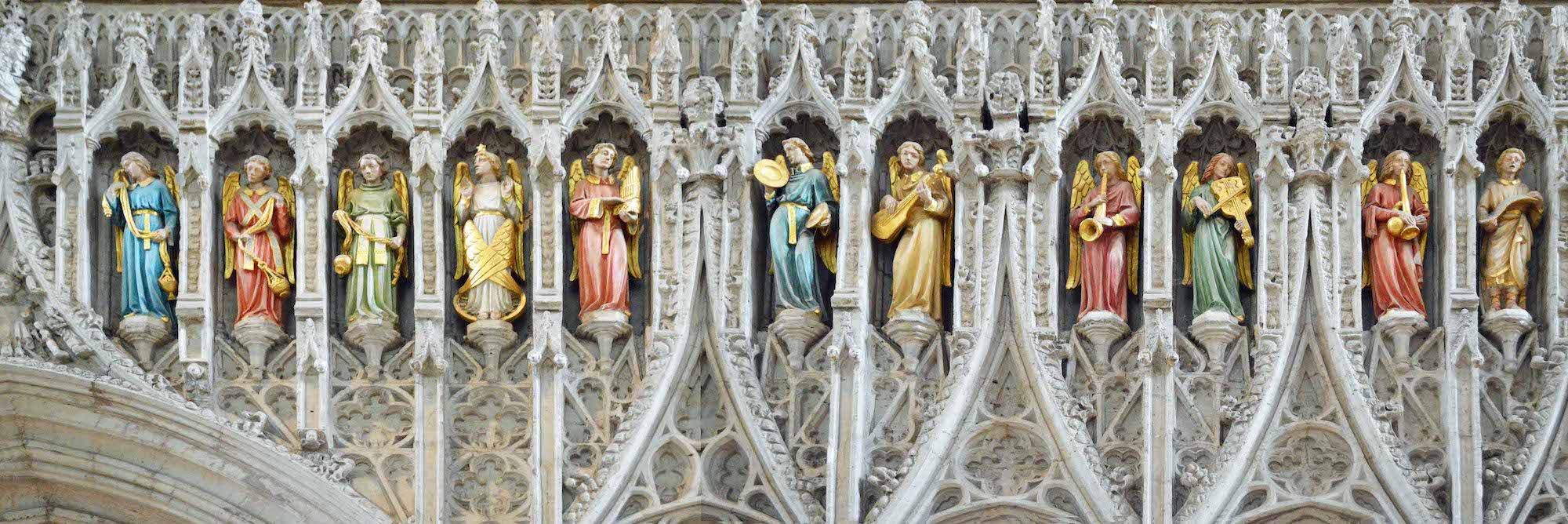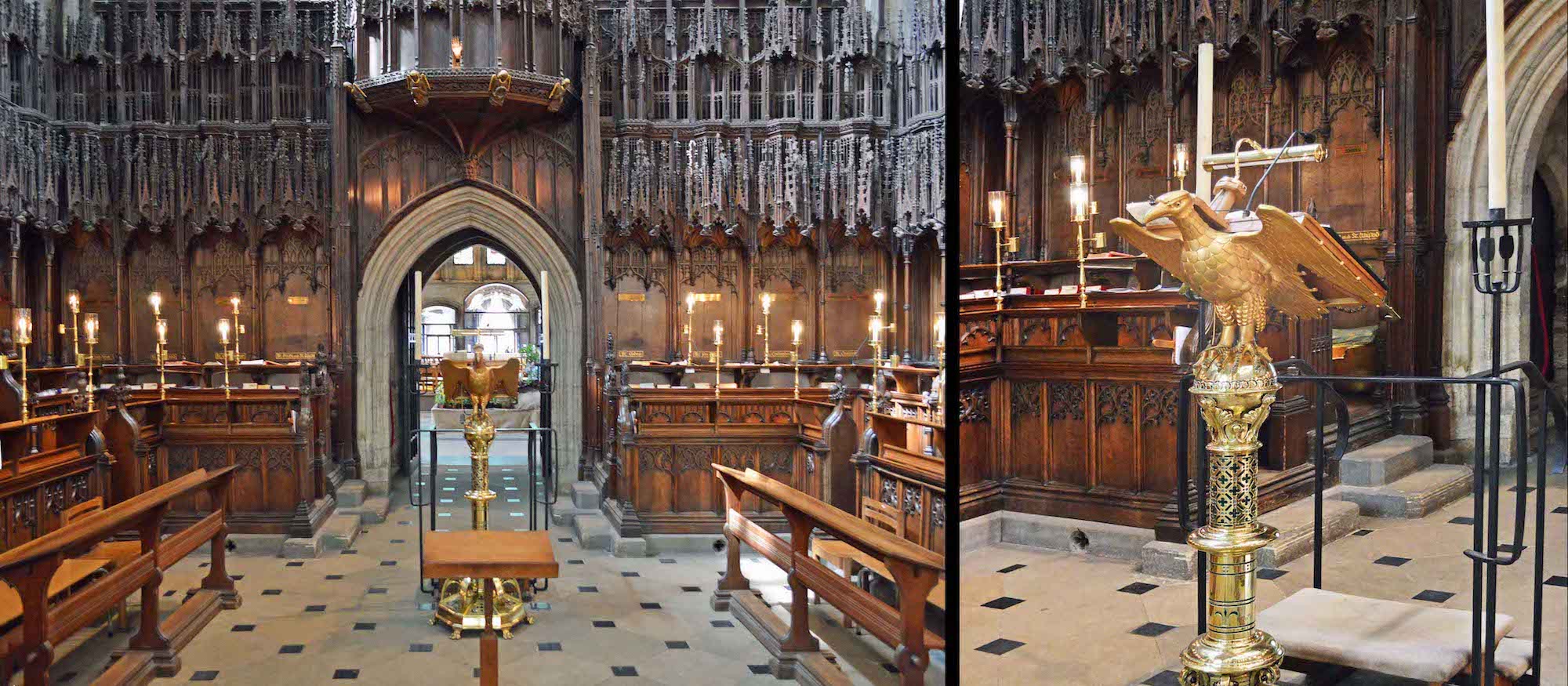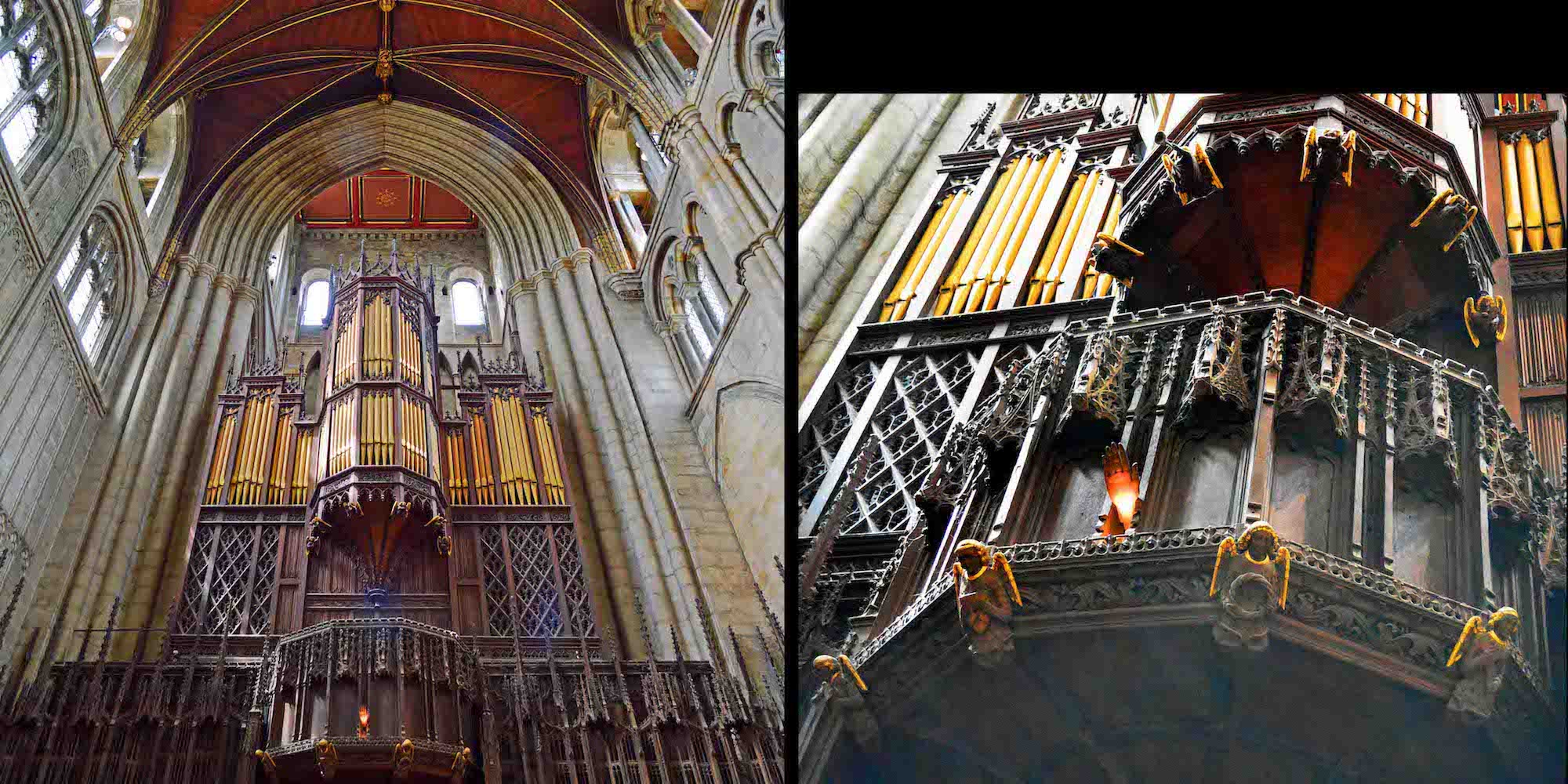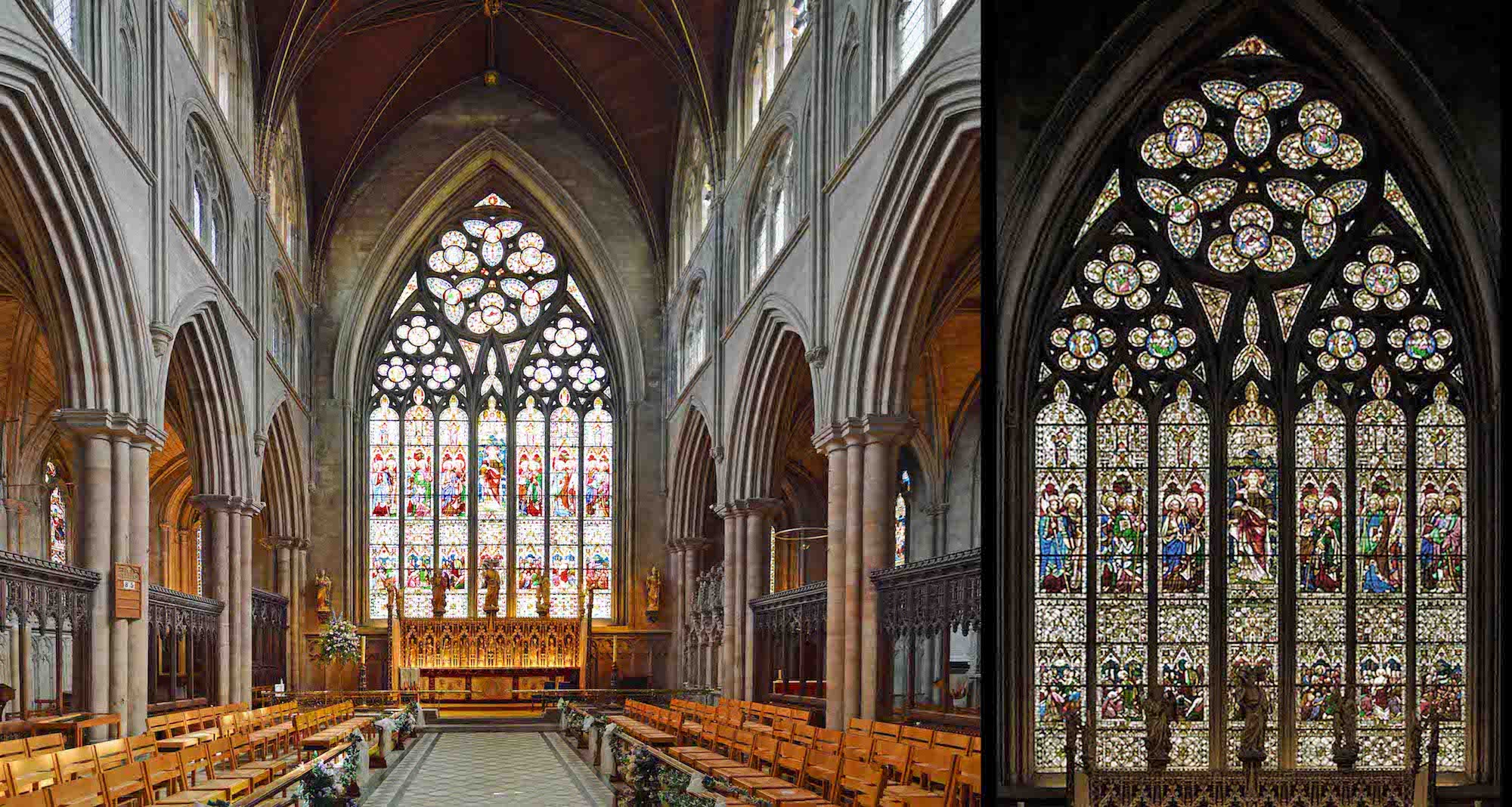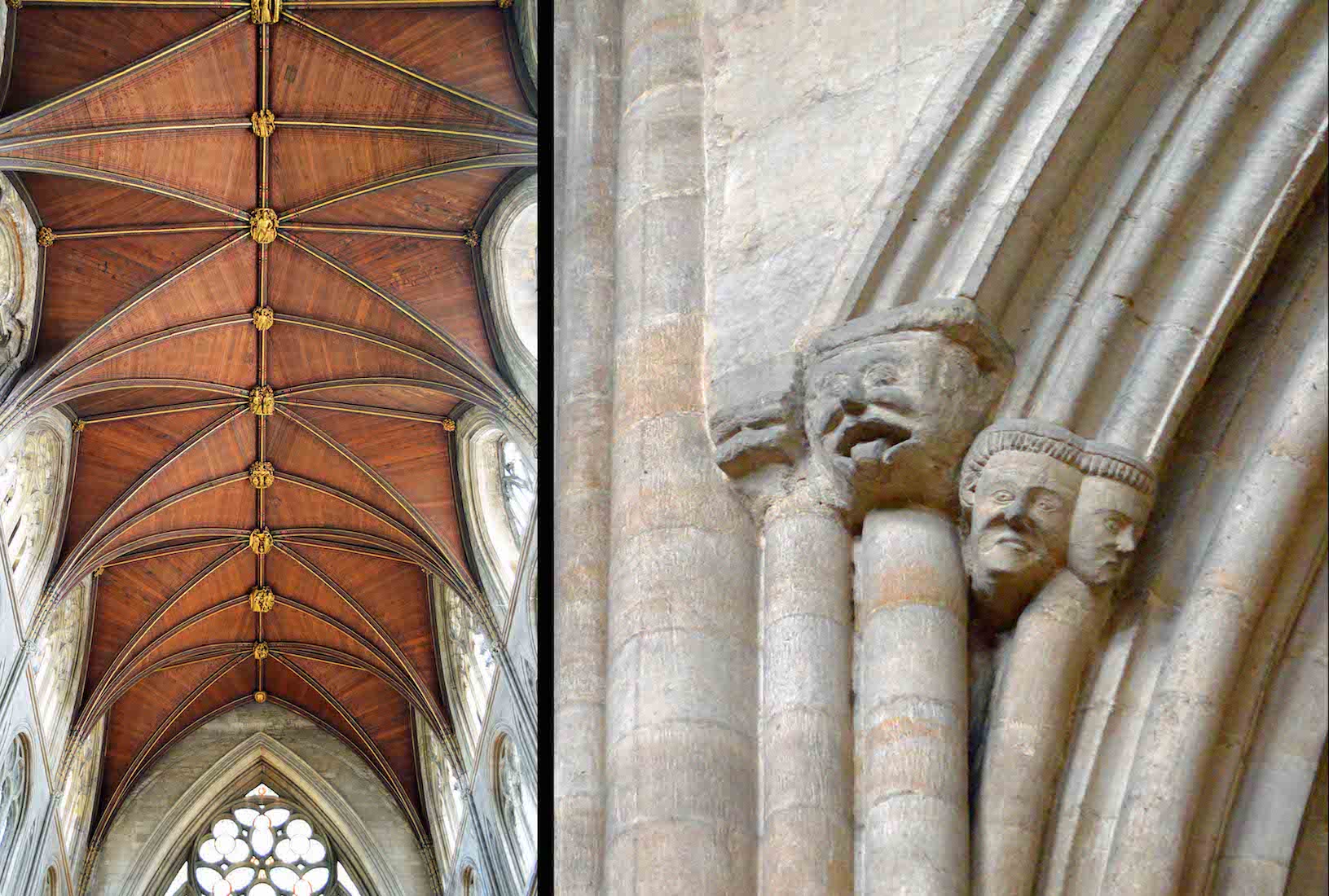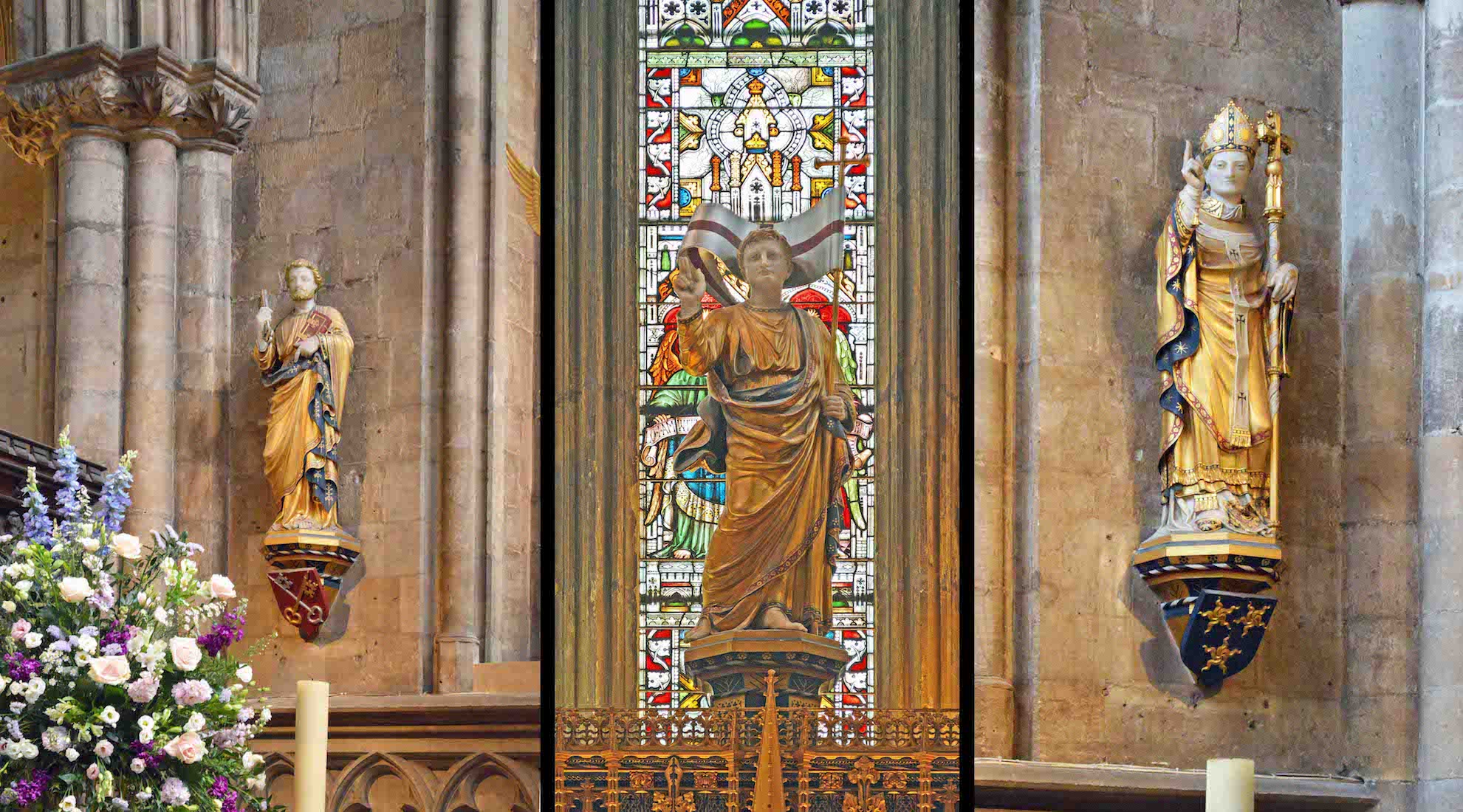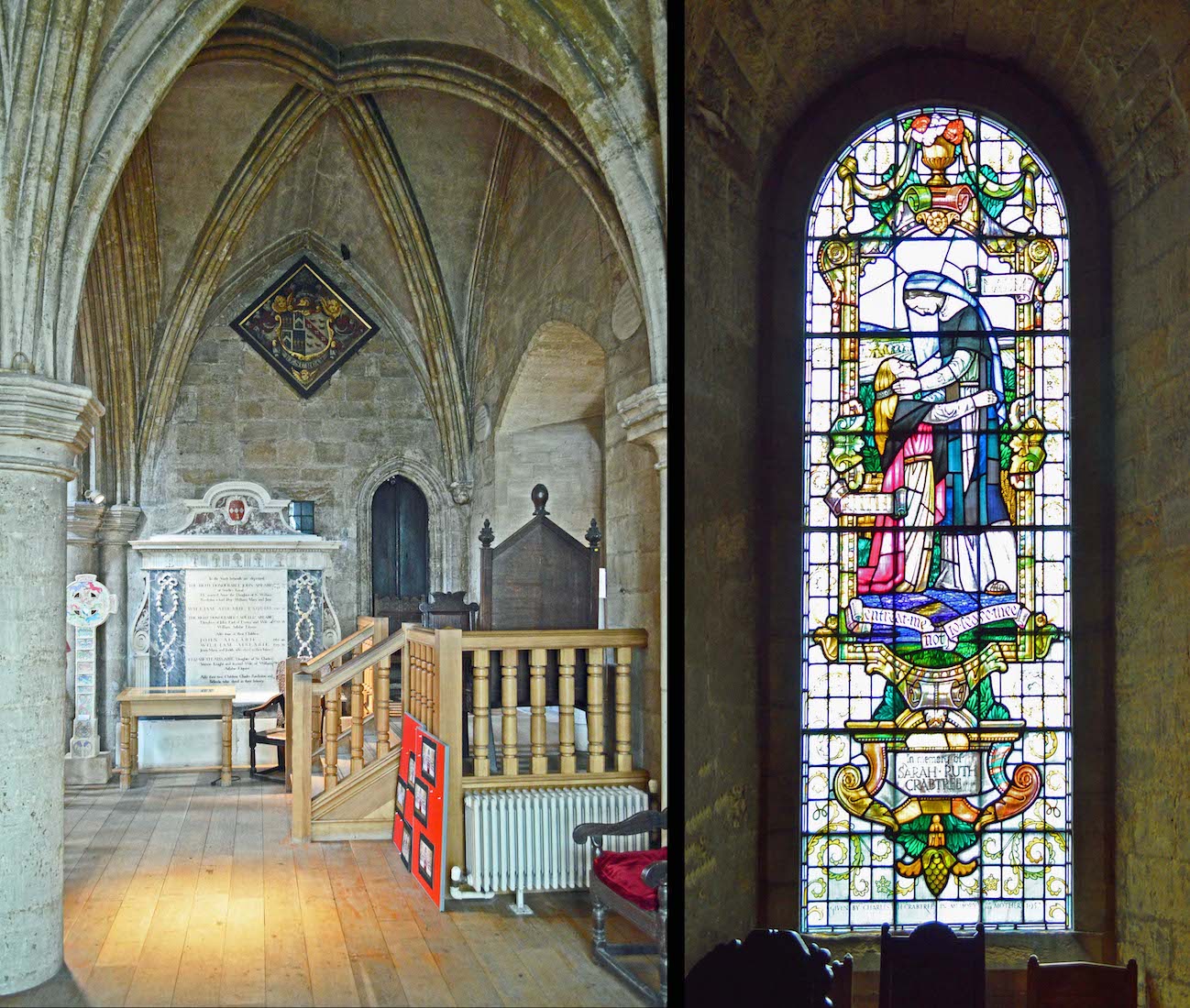
Climbing the stairs leads us first to the balcony where there is a view across to a further window. The window shows Naomi with a very young Ruth, and the words ‘Entreat me not to leave thee.’ We then come in to the foyer of the library. High on the South wall is a hatchment with the legend ‘Resurgam’, meaning ‘I shall rise again’. Below is a monument to John Aislabe and his descendents PLAN
62. LIBRARY LOOKING EAST

We enter the spacious library. This was built above the chapter house in the early 14th century as a chapel to the Virgin Mary. It hs been used as a library since the 17th century. We notice the mantle display at right above the grand piano, the cabinets of treasured items, the stained glass windows at the far end, and the paintings on the wall at left.
63. ORNATE CROSS, MANTLE
The treasury has a display of communion plate and church silver dating from the 1570s. There are goblets, tankards, jugs and processional crosses. At left is shown a large altar cross – a treasury item. And at right is an attractive mantle display with a curious black vestment surrounded by various coats of arms..
64. LIBRARY WINDOWS
These windows are down at the East end of the library. The most impressive is the heraldic East window, depicting 15 coats of arms.
65. LIBRARY ROYAL PAINTINGS
These portraits on the North wall depict kings and queens of the 15th and 16th centuries, and were probably painted during the reign of King James I (1603–1625).
66. LIBRARY LOOKING WEST
The library is indeed a very pleasant room. Here we look back towards the entrance. Notice the Cathedral models on the right hand side.
67. MODEL CATHEDRALS
These three models show the Cathedral development at different times – according to the blue cards, in the 11th, 12th and 16th centuries. We might notice the addition of the West wall and towers, the addition of the nave side aisles, the building of the library, and the unfortunate loss of the three spires. In fact, in 1615 the spire on the crossing tower collapsed, and in 1664 the spires on the two Western towers were taken down.
68. MADONNA
As we leave the library and South transept we pass a third Madonna and Child standing by the Southwest crossing pillar. This is the third of three copper statues of the Virgin Mary and Jesus in Ripon Cathedral, made between 1998-2000 by Yorkshire artist Harold Gosney.
70. LOWER PULPITUM FIGURES
The present statues were installed in 1947 and painted in 1958. They represent significant royal and ecclesiastical figures from the Cathedral’s history. Each of these larger figures has the name inscribed below, in Latin. Thus King James I is seventh from the left with name ‘Jacobus I’.
71. UPPER PULPITUM FIGURES, NORTH
The upper row of figures in the screen are of various musical angels. Those shown here are on the left side ...
72. UPPER PULPITUM FIGURES, SOUTH
... whilst these are on the right.
74. QUIRE VIEW, LECTERN
The quire lectern is the traditional eagle in design, but a little different from the ordinary. We might notice too the unusual mechanical hand up by the organ. This dates from 1695 and can be operated by the organist to beat time for the choir.
75. ORGAN
The first reference to an organ in Ripon Cathedral occurs in the Fabric Rolls for 1399. The present-day, four-manual organ contains two ranks from a 1690 organ. Its history really begins, however, in 1878, when it was almost entirely built from scratch by T C Lewis of Brixton. Costing the grand sum of £4,000 without the case, this organ was undoubtedly one of the finest of its day.
76. QUIRE STALLS
The quire stalls were made by a team of local carvers between 1489 and 1494, and have carved fronts and ends. The back row have high backs and are set under a fan vaulted canopy decorated with dozens of crocketed pinnacles. Each stall in the back row has a lifting seat with an ornately carved ledge on the underside called a misericord (or mercy seat), designed for the monks to lean against during long services.
77. MISERICORDS
It is worth investigating the misericords, perhaps carved by the master carver William Bronfleet, mayor of Ripon in 1511. One of these is dated 1489 on a shield. The misericord shown at right may have been inspiration for Lewis Carroll’s Alice in Wonderland. It depicts a gryphon attacking a rabbit while a second rabbit disappears down a hole (as did the White Rabbit and Alice herself). [Photo Credit: Cathedral Photo]
78. SANCTUARY AND EAST WINDOW
The Great East Window dates from about 1300, although the glass by William Wailes depicting Christ commissioning his disciples, is Victorian. We shall examine the high altar more closely shortly, but on the South side of the altar are three stone seats, early 14th century sedilia, where the clergy sit.
79. QUIRE VAULTING, HEADS
High above the quire and sanctuary is a fine vaulted ceiling with ornate golden bosses. Carved heads look down from the top of one of the columns.
80. SANCTUARY FIGURES
Painted carved figures stand along the top of the reredos above the high altar, and there is a figure on either side – St Peter at left (North) and St Wilfrid at right (South). The figure shown here is the central figure of a beardless Christ, an allusion to the youth of those killed in the First World War. Not shown are the flanking figures of St George and St Michael.


